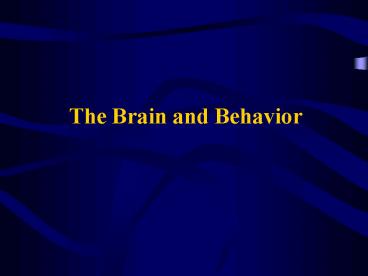The Brain and Behavior - PowerPoint PPT Presentation
1 / 62
Title:
The Brain and Behavior
Description:
And by the same organ we become mad and delirious, and fears and terrors assail ... Nikola Tesla had abnormally long thumbs, a peculiar love of pigeons, and ... – PowerPoint PPT presentation
Number of Views:608
Avg rating:3.0/5.0
Title: The Brain and Behavior
1
The Brain and Behavior
2
- Men ought to know that from nothing else but the
brain come joys, delights, laughter and sports,
and sorrows, griefs, despondency and
lamentations. And by this, in a special manner,
we acquire wisdom and knowledge, and we see and
hear, and know what are foul and what are fair,
what are bad and what good, what are sweet and
what unsavory . . . And by the same organ we
become mad and delirious, and fears and terrors
assail us, some by night and some by day, and
dreams and untimely wanderings . . .
- Hippocrates
3
What do these 5 things have in common?
0
- A brain tumor
- A womans menstrual period
- Eating junk food
- Taking anabolic steroids
- Taking an anti-depressant (Zoloft)
4
- The brain and behavior
- -How does the brain work?
- -What makes you who you are, and how do you
make the decisions you make? - Psychopathology and Neuropathology
- -Psychopathology
- -Neuropathology
- -The oddities of genius
- 3. Bad news and good news
- -Labels
- -Bioethics
- -Understanding and hope
5
The Human Brain
6
Brain Divisions
7
Inside the Brain
8
The Ideal Neuron
Dendrite
Cell Body
- Myelinated
- Axon
Axon Terminals
Axon Hillock
9
A Real Neuron
10
Neurons have three parts
Dendrite
Cell Body
Axon
11
Neurons are batteries (they store an electrical
charge)
12
Action Potential
During an action potential the battery is
discharged
13
Action Potential
Positive ions flow in
Negative ions flow out
14
Action Potential
Until the battery
is discharged
15
Transmitter Release
This discharge (action potential) causes
the release of neurotransmitter
16
Synaptic Transmission
This neurotransmitter can, in turn, help cause
another nearby neuron to fire an action
potential
17
Synaptic Transmission
and release neurotransmitter
18
Synaptic Transmission
Note, the original neuron has recovered
(recharged)
19
Neural Networks
Neurons can be hooked up together to form networks
20
Neural Networks
For example,
21
Neural Networks
Mutually excitatory pairs
22
Neural Networks
Mutually excitatory pairs
23
Neural Networks
Or loops
24
Neural Networks
Or loops
25
Neural Networks
Or loops
26
Neural Networks
Or loops
27
Neural Networks
Or loops
28
Excitatory Neuron
Inhibitory Neuron
29
Excitatory Neuron
Inhibitory Neuron
30
Excitatory Neuron
Inhibitory Neuron
31
Excitatory Neuron
Inhibitory Neuron
32
Excitatory Neuron
Inhibitory Neuron
33
Excitatory Neuron
Inhibitory Neuron
34
Seven
35
Seven
36
Seven
Finished Dialing
37
Network is Turned Off
Finished Dialing
38
Step 1
Threat
Make War
Make Conciliatory Gesture
39
Step 2
Threat
Make War
Make Conciliatory Gesture
40
Step 3
Threat
Make War
Make Conciliatory Gesture
41
Step 4
Threat
Make War
Make Conciliatory Gesture
42
Step 5
Threat
Make War
Make Conciliatory Gesture
43
Step 6
Threat
Make War
Make Conciliatory Gesture
44
Step 7
Threat
Make War
Make Conciliatory Gesture
45
Step 8
Threat
Make War
Make Conciliatory Gesture
46
Step 9
Threat
Make War
Make Conciliatory Gesture
47
Step 10
Threat
Make War
Make Conciliatory Gesture
48
Number of Neurons Number of Possible States
14
16,384
20
1,048,576
30
1,073,741,824
40
1,099,500,000,000
100,000,000,000 (Your Brain)
????
49
Psychopathology
- Huntingtons Chorea
- Frontal Lobe Disinhibition
- Phineas Gage
50
Prefrontal Lobotomy
- See page 47 in text
- Animal studies Jacobsen, Wolfe and Jackson
(1935). - Becky the chimp
- Frontal lobe removal reduced frustration reaction
and violent behaviors - Egas Moniz Nobel Prize (1949)
- Could one reduce anxiety and frustration
surgically?
51
Prefrontal Lobotomy Transorbital
leucotomePatients could have lobotomy in Drs
Office
52
Prefrontal Lobotomy
- Tens of thousands done in 50s - 70s
- Results
- Reduced violent behaviors
- Irresponsible and childlike
- Unemployable
- Different personality
53
Psychopathology
- Obsessive-Compulsive Disorder
- - Runs in families genetic component
- - Increased metabolism in the prefrontal lobe
area - - We all often experience mild forms
54
Psychopathology
- Obsessive-Compulsive Disorder
55
Psychopathology
- Schizophrenic and Schizotypal Personality
56
Psychopathology
Epilepsy
- Temporal Lobe Personality Disorder
- -Hypergraphia
- -Neophobia
- -Deep interest in religious issues
57
Charlie Whitman
58
The Criminal Mind (Brain?)
- Psycho pathology of Crime Criminal Behavior as a
Clinical Disorder Adrian Raine, University of
Southern California (Book) - The Psychopaths Brain Renato M.E. Sabbatini,
University of Sao Paulo,Brazil and post doctoral
fellow at Max Planck Institute of Psychiatry,
Munich, Germany (web paper) - The Executive Brain Frontal lobes and the
civilized Mind Elkhonon Goldberg, New York
University School of Medicine (book)
59
The Criminal Brain
- Traumatic brain injury
- Chemical ingestion (e.g., cocaine, lead, other
drugs) - Birth injuries
- Neurodevelopmental abnormalities
- Genetic abnormalities
- Electrocution
- Tumors
- Extreme environmental exposures (gasses,
radiation) - Nutritional deficiencies
60
The Oddities of Genius
- Legendary inventor Nikola Tesla had abnormally
long thumbs, a peculiar love of pigeons, and a
horror of womens pearls. - Forefather of modern electric-circuit design,
Oliver Heaviside, furnished his home with granite
blocks and sometimes consumed only milk for days
(as did Nikola Tesla and Thomas Edison). - Renowned scholar Samuel Johnson had so many tics
and quirks that some mistook him for an idiot.
In fact, his behavior matches modern definitions
of obsessive-compulsive disorder and Tourettes
syndrome.
61
The Continuum
62
Bad News and Good News
- Labels can be dangerous.
- Bioethics
- Just because we can, should we?
- Jury duty
- Knowledge fosters understanding, help, and
hope. - The future is up to you.































